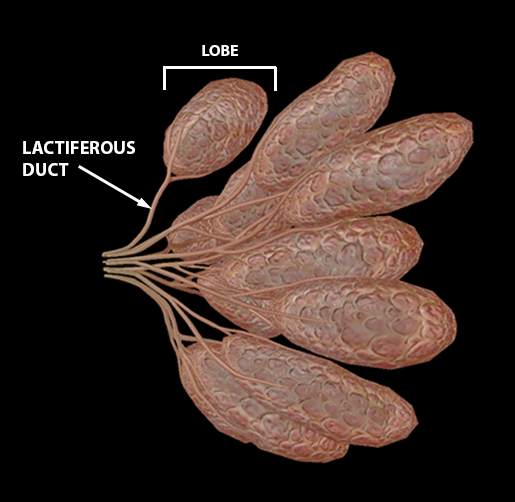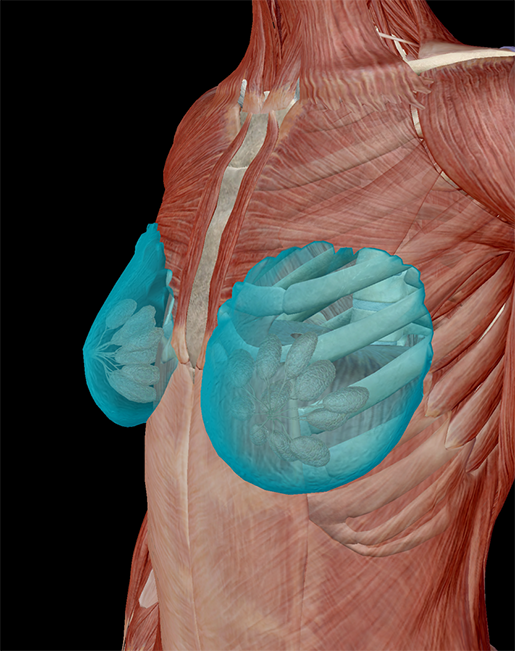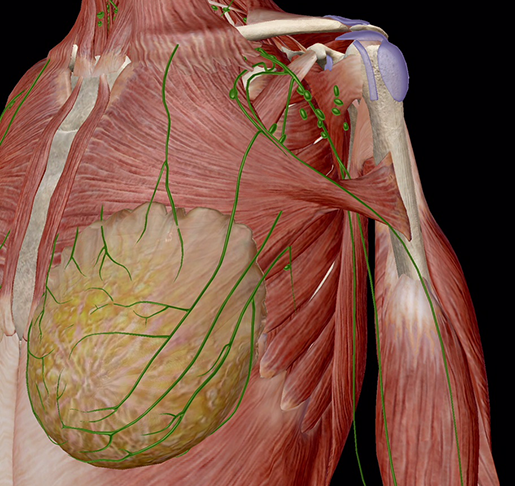Five Breast Cancer Facts
Posted on 4/9/19 by Laura Snider
Today, we’re going to talk about breast cancer, one of the most common cancers diagnosed in women.
Cancer happens when cells in the body replicate without restriction. Usually, our bodies do a pretty good job of regulating the production of new cells to replace those that have died out. However, problems (i.e. tumors) arise when certain cells develop mutations that allow them to multiply without restriction and spread to other areas of the body.
Breast Anatomy Basics
Before we get to the facts, let’s talk about the structures inside breasts. Both males and females have breasts, but we’re going to focus primarily on female breasts here.
During puberty, the female breast develops lobules that contain cells capable of producing milk.
These cells are called (mammary) alveoli. The lobules they compose are organized into 15-20 lobes in each breast. The lobes are connected by tubes called milk ducts—lactiferous ducts, if you want to sound fancy—that carry milk to the nipple.
 Image from Human Anatomy Atlas.
Image from Human Anatomy Atlas.
Loose connective tissue (areolar tissue) connects the lobules to one another, while fatty tissue (highlighted blue in the image below) surrounds and fills the spaces between lobes.
 Image from Human Anatomy Atlas.
Image from Human Anatomy Atlas.
The breast and armpit also contain lymph nodes and ducts, which carry lymph fluid and white blood cells. Along with the bloodstream, lymph ducts are one of the routes by which cancer can spread (metastasize) to other areas of the body.
 Image from Human Anatomy Atlas.
Image from Human Anatomy Atlas.
And now for the facts.
1. 12% of women (1 in 8) develop breast cancer during their lifetime.
In the U.S., about 237,000 cases of breast cancer are diagnosed in women each year. Additionally, 2,100 cases of breast cancer occur in men. The CDC reports that “about 41,000 women and 450 men in the U.S. die each year from breast cancer.” Because the risk of getting breast cancer increases with age, the average age of breast cancer diagnosis for women in the U.S. is 61. The average age for diagnosis in men is between 60 and 70.
2. There are multiple types of breast cancer.
The chart below details some of the types of breast cancer:
|
Ductal Carcinoma in Situ |
An early form of breast cancer in which abnormal cells are found within the ducts of the breast but haven’t invaded surrounding tissues. |
|
Invasive Ductal Carcinoma |
Starts in the ducts of the breast but spreads to other breast tissues. Accounts for 80% of new breast cancer diagnoses. |
|
Inflammatory |
An aggressive, rapidly progressing (but less commonly-occurring) cancer affecting the lymph system in the breast. May start as IDC. Can present similarly to an infection (breast tissue is red and feels warm). |
|
Invasive Lobular Carcinoma |
Originates in the lobules of the breasts. |
|
Occurs when cancer cells lack HER-2, estrogen, and progesterone receptors. |
3. Young women can get breast cancer. So can men.
Though most women diagnosed with breast cancer are 50 and older, around 11% of new breast cancer diagnoses are in women under 45.
However, breast cancer isn’t exclusive to the female breast. Though “breast cancer is around 100 times less common in men than it is in women,” men do get breast cancer. Ductal carcinoma is responsible for most cases of male breast cancer—even though female breasts form lobules during puberty while men’s breasts don’t, both male and female breasts still have ducts and nipples.
4. Mutations in certain genes are associated with a higher risk for breast cancer.
Breast cancer itself doesn’t run in families, but there are certainly some inherited gene mutations that can cause an increased risk of developing breast cancer.
For example, the BRCA1 and BRCA2 genes code for proteins that help repair damaged DNA. These proteins are often referred to as “tumor suppressors” because “they help keep cells from growing and dividing too fast or in an uncontrolled way.” When the BRCA1 and BRCA2 genes are mutated, these repair functions are impaired, meaning that mutations in DNA can persist and potentially lead to the unchecked growth characteristic of cancer. Certain genetic syndromes that involve similar mutations affecting “tumor suppressors” can also contribute to an increased risk of breast cancer (and other cancers as well).
Still, most cases of breast cancer are sporadic—that is, they arise without a known genetic cause.
5. There are "normal" and "abnormal" breast changes, and not all breast cancers cause lumps!
Healthy breasts undergo changes throughout a person's lifespan. They can feel tender around the time of a woman’s menstrual period or before menopause, for example. During pregnancy, the breasts might feel lumpy due to the increase in size and number of milk-producing glands. The nipples and areolas also typically become larger and darker in color during pregnancy as well.
However, changes outside the norms of age and hormone-related changes could mean something’s not right.
The CDC lists the following symptoms as potential warning signs for breast cancer.
-
New lump in the breast or underarm (armpit).
-
Thickening or swelling of part of the breast.
-
Irritation or dimpling of breast skin.
-
Redness or flaky skin in the nipple area or the breast.
-
Pulling in of the nipple or pain in the nipple area.
-
Nipple discharge other than breast milk, including blood.
-
Any change in the size or the shape of the breast.
-
Pain in any area of the breast.
These symptoms can be indicative of other breast conditions, but it’s always a good idea to talk to a medical professional if you’re concerned.
Though yearly mammograms aren’t recommended until age 40, it’s still important for women to have a clinical breast exam conducted by a doctor every three years after age 20 (and every year after age 40). If you notice any unusual changes in the look or feel of your breasts, discuss them with your doctor.
Be sure to subscribe to the Visible Body Blog for more anatomy awesomeness!
Are you a professor (or know someone who is)? We have awesome visuals and resources for your anatomy and physiology course! Learn more here.
Additional Sources:






